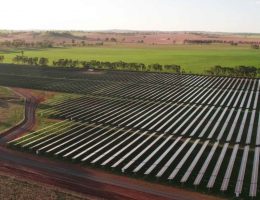The Morrison government has picked five technologies that will receive prioritised support under its Technology Roadmap launched on Tuesday, a plan which includes no new emissions reduction targets but which is supposed to form the basis of the Coalition’s climate and energy policy.
Federal energy and emissions reduction minister Angus Taylor launched the Technology Roadmap during a speech to the National Press Club in Canberra on Tuesday, with the focus firmly on technologies that favour fossil fuels, farmers and big energy users such as steel and aluminium manufacturers.
The Technology Roadmap is the latest energy policy from the Coalition, which has gone through more than 20 iterations during seven years of government and continues its trend of directing taxpayer funding into preferred technologies, rather than policies that place a price on emissions.
“Let’s be clear – there are only two ways to reduce emissions,” Taylor said in a speech to the National Press Club on Tuesday.
“You either suppress emissions-intensive economic activities – usually through some version of taxation – or you improve them. There is no third way. Australia can’t and shouldn’t damage its economy to reduce emissions.”
Taylor said that the government would focus on five priority technologies that would receive targeted government investment, being “clean” hydrogen, energy storage, low-carbon steel and aluminium, carbon capture and storage, and soil carbon.

The focus on “clean hydrogen”, rather than renewable hydrogen, and the renewed embrace of CCS raise particular concern as they will likely favour legacy fossil technologies. Other technologies such as electric vehicles and batteries are now second-order priorities, while wind and solar are lumped with coal and gas as “mature technologies” that will receive no further support.
“Priority technologies are those expected to have transformational impacts here and globally and are not yet mature,” Taylor told the National Press Club.
“They are priorities where government investments can make a difference in reducing costs and improving technology readiness.”
“Technologies where we, as a government, will not only prioritise our investments but where we will streamline regulation and legislation to encourage investment,” Taylor said.
Under the Technology Roadmap, the Morrison government will monitor a number of emerging technologies, including small modular nuclear reactors, which may also receive government support pending future developments overseas.
Taylor said that the Technology Roadmap would be used to guide up to $18 billion in investment, but it is unclear how much of this – if any – is new funding and how much will actually be able to be deployed by the main agency, the Clean Energy Finance Corp.
“The roadmap will guide the deployment of the $18 billion that will be invested, including through the CEFC, ARENA, the Climate Solutions Fund and the CER,” Taylor said.
“This will turn that into at least $50 billion through the private sector, state governments, research institutions and other publicly funded bodies. That will drive around 130 000 jobs to 2030.”
The CEFC already manages $10 billion in funds, along with an additional $1 billion set to be allocated under the Grid Reliability Fund. ARENA already manages $2 billion in grant funding, with an additional $1.9 billion set to be given to the agency; and the Clean Energy Regulator already manages the $2 billion Climate Solutions Fund.
Taylor said that the government expects the plan to “support” 130,000 jobs by 2030 and to “avoid” 250 million tonnes of emissions a year by 2040, but it is also unclear how these figures have been calculated.
The government has set itself a series of four ‘stretch goals’, which do not include an emissions reduction target, but set goals for reducing the cost of the government’s ‘priority technologies’.
These stretch goals include achieving long-term (at least eight to 10 hours) energy storage at an equivalent cost of less than $100 per MWh, carbon dioxide storage at less than $20 per tonne, low emissions steel below $900 per tonne and aluminium below $2,700 per tonne, and the ability to measure soil carbon content at below $3 per hectare per year.
With no additional emissions reduction targets specified under the roadmap, the government appears set to present the roadmap, and a series of future ‘Low Emissions Technology Statements’, as its future action pledge in international climate talks.
Taylor suggested that the government would wind back support for investments in wind and solar projects, lumping them together with coal and gas, but would consider intervening in the market when there were market failures.
“There is no doubt that existing, proven technologies like coal, gas, solar and wind will play important roles in Australia’s energy future,” Taylor told the Press Club.
“The government will continue to invest in mature technologies where there is a clear market failure, like a shortage of dispatchable generation.”
Prime minister Scott Morrison has already indicated that he may use government-owned Snowy Hydro to build a new gas generator in the Hunter Region, a market intervention that has not been received well by the rest of the energy market.
Labor’s shadow minister for climate change and energy, Mark Butler, said that the technology roadmap lacked the policies needed to actually drive investment and guide Australia’s energy transition.
“This is typical Scott Morrison – another plan to have a plan but no actual policy,” Butler said. “No policy to help reduce power prices. No policy to give investors the confidence to build new generation and ensure reliable energy.
“This technology roadmap is useful as far as it goes but there is no shortage of reports lining government bookcases about energy technology, all of which confirm that the cheapest and the cleanest way to renew our ageing, increasingly unreliable electricity system is renewable energy and storage.
“What Australia has desperately needed is a genuine energy policy to drive investment in affordable, reliable, clean power.”
Taylor said that the government would establish an ongoing advisory council, the Technology Investment Advisory Council, to advise on the development of the ‘Low Emissions Technology Statements’, which would be chaired by chief scientist Dr Alan Finkel.
Membership of the council would include the heads of the CEFC, ARENA and the Clean Energy Regulator, along with those who advised on the creation of the technology roadmap.
This group includes former Origin Energy CEO Grant King, CEO of Australian Gas Infrastructure Group Ben Wilson, the group managing director of Coca-Cola Amatil Alison Watkins and CEO of Macquarie Group Shemara Wikramanayake.
The advisory group will not include any representatives of the clean energy sector, outside those appointed by the government to head the three government agencies.










